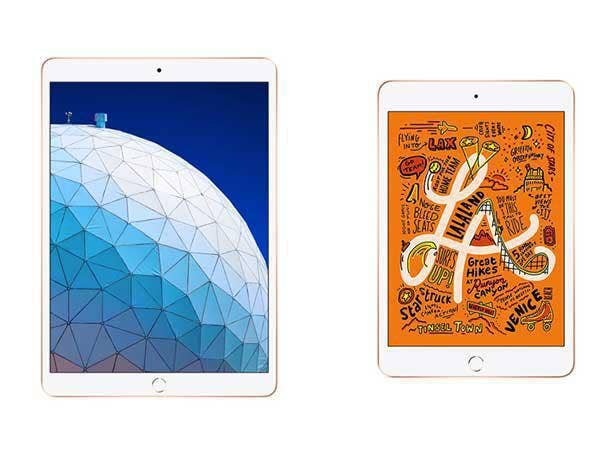Apple CEO: Mac, iPad Businesses Are ‘Very Strong,’ iPhone Sees ‘Significant Improvement’
The iPad and Mac businesses saw continued momentum following a series of product refreshes by Apple, while iPhone revenue did not drop as dramatically during Apple’s latest quarter.

Apple's expanded investments into non-iPhone hardware launches appear to be paying off, helping to return the tech giant to growth even as iPhone revenue continues to slide.
On Tuesday, Apple reported that overall revenue for its third quarter of fiscal 2019, ended June 29, climbed year-over-year--marking the company's first revenue increase in three quarters.
[Related: The 10 Biggest Apple News Stories Of 2019 (So Far)]
It wasn't a big jump--revenue was up 1 percent from the same quarter a year earlier, reaching $53.81 billion. But it still showed the strength of Apple's Mac, iPad, services and wearables businesses at a time of diminished demand for the iPhone.
The Mac and iPad portfolios have received heightened attention from Apple thus far in 2019. For Mac, the company has unveiled updates to all three of its MacBook Pro models, along with refreshes to the MacBook Air and iMac, and a major redesign of the Mac Pro.
For fiscal Q3, Apple reported that Mac revenue rose 10.6 percent to $5.82 billion. The company is "very happy" with the results, CEO Tim Cook said during a quarterly call with analysts. The MacBook Air and MacBook Pro, in particular, saw "strong performance" during the quarter, Cook said.
For iPad, third-quarter revenue climbed 8.4 percent to reach $4.63 billion. The results were "driven by iPad Pro and by strong customer response to the new iPad Mini and iPad Air," Cook said.
It's the third quarter in a row sequentially of year-over-year sales growth for iPad, and revenue is up roughly 15 percent year to date, he said.
"We feel great about where we're at with iPad," Cook said during the quarterly call.
In March, Apple launched refreshed versions of the iPad Mini and iPad Air, following several years without updates to either of the tablets. Key upgrades with the third-gen iPad Air and fifth-gen iPad Mini include the addition of support for the Apple Pencil stylus for both tablets, as well as performance improvements.
Meanwhile, Apple announced in June that it's splitting off the iPad operating system from the iPhone, with the introduction of iPadOS. The operating system will be meant to take advantage of the larger form factor on the iPad in numerous ways, such as with enhanced split-view multi-window capabilities. Apple plans to make iPadOS available in the fall.
Glenn Gruber, senior digital strategist at Blue Bell, Pa.-based Anexinet, No. 218 on the CRN Solution Provider 500, applauded the moves by Apple around the iPad.
Apple has been "putting a lot of energy into making the iPad a much more enterprise-friendly platform. I think that in and of itself is a big deal," Gruber told CRN. "Apple has oftentimes talked about the iPad as being their best vision for the future of computing. There has been some angst over whether that meant pushing iOS and iPad to the detriment of macOS and power users. But I would hope that those concerns have been quelled with the release of the iMac Pro and the amazing Mac Pro."
Key features for business users in iPadOS include improved file management and file sharing, support for USB-C thumb drives and better multi-tasking capabilities, Gruber said. Overall, the iPad has "come very far" in terms of its usefulness to businesses, he said.
Cupertino, Calif.-based Apple also saw surging growth in its Wearables, Home and Accessories business during its fiscal third quarter (up 48.2 percent year-over-year to $5.53 billion), and continued momentum in Services revenue (up 11.3 percent to $11.46 billion).
iPhone
While the iPhone business continued to see contraction during fiscal Q3, the results represented "significant improvement in year-over-year iPhone performance," Cook said. Revenue for iPhone was down 11.8 percent, to $25.97 billion, from the same quarter a year before.
That compares to steeper drops in iPhone revenue of 17 percent in Apple's fiscal second quarter and 15 percent during fiscal Q1. Trade-in and financing programs offered by Apple for iPhone are picking up steam, Cook said.
In recent quarters, Apple has blamed the drop in iPhone sales on poor demand in China and a slow pace of upgrades in developed markets.
For the fiscal third quarter, Apple reported net income of $10.04 billion, or earnings of $2.18 per diluted share. That's down from net income $11.52 billion, or earnings of $2.34 per diluted share, during the same period of 2018.
Intel Modem Acquisition
Additionally, Cook commented on Apple's agreement to acquire the majority of Intel's smartphone modem business. The $1 billion deal, expected to close in the fourth quarter, will include intellectual property, equipment and 2,200 employees from Intel.
The acquisition will allow Apple “to grow our portfolio of wireless technology patents to over 17,000, to expedite our development of our future products and to further our long-term strategy of owning and controlling the primary technologies behind the products that we make," Cook said during the quarterly call.
Mac Pro Manufacturing
In response to a question from an analyst during the call, Cook also said that manufacturing of the Mac Pro will continue to be performed in the U.S., contradicting reports that the work will be shifting to China. President Donald Trump tweeted last week that Apple would not receive waivers on tariffs for Mac Pro components produced in China, which had been requested by the company.
"In terms of the exclusions, we've been making the Mac Pro in the U.S. We want to continue doing that,” Cook said. “So we're working and investing currently in capacity to do so. Because we want to continue to be here. So that's what's behind the exclusion. So we're explaining that, and hope for a positive outcome.”